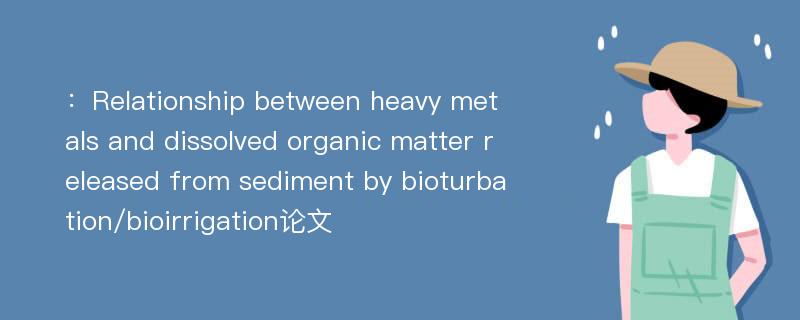
本文主要研究内容
作者(2019)在《Relationship between heavy metals and dissolved organic matter released from sediment by bioturbation/bioirrigation》一文中研究指出:Organic matter(OM) is an important component of sediment. Bioturbation/bioirrigation can remobilize OM and heavy metals that were previously buried in the sediment. The remobilization of buried organic matter, thallium(Tl), cadmium(Cd), copper(Cu) and zinc(Zn) from sediment was studied in a laboratory experiment with three organisms: tubificid,chironomid larvae and loach. Results showed that bioturbation/bioirrigation promoted the release of dissolved organic matter(DOM) and dissolved Tl, Cd, Cu and Zn, but only dissolved Zn concentrations decreased with exposure time in overlying water. The presence of organisms altered the compositions of DOM released from sediment,considerably increasing the percentage of fulvic acid-like materials(FA) and humic acidlike materials(HA). In addition, bioturbation/bioirrigation accelerated the growth and reproduction of bacteria to enhance the proportion of soluble microbial byproduct-like materials(SMP). The DOM was divided into five regions in the three-dimensional excitation emission matrix(3 D-EEM), and each part had different correlation with the dissolved heavy metal concentrations. Dissolved Cu had the best correlation with each of the DOM compositions, indicating that Cu in the sediment was in the organic-bound form.Furthermore, the organism type and heavy metal characteristics both played a role in influencing the remobilization of heavy metal.
Abstract
Organic matter(OM) is an important component of sediment. Bioturbation/bioirrigation can remobilize OM and heavy metals that were previously buried in the sediment. The remobilization of buried organic matter, thallium(Tl), cadmium(Cd), copper(Cu) and zinc(Zn) from sediment was studied in a laboratory experiment with three organisms: tubificid,chironomid larvae and loach. Results showed that bioturbation/bioirrigation promoted the release of dissolved organic matter(DOM) and dissolved Tl, Cd, Cu and Zn, but only dissolved Zn concentrations decreased with exposure time in overlying water. The presence of organisms altered the compositions of DOM released from sediment,considerably increasing the percentage of fulvic acid-like materials(FA) and humic acidlike materials(HA). In addition, bioturbation/bioirrigation accelerated the growth and reproduction of bacteria to enhance the proportion of soluble microbial byproduct-like materials(SMP). The DOM was divided into five regions in the three-dimensional excitation emission matrix(3 D-EEM), and each part had different correlation with the dissolved heavy metal concentrations. Dissolved Cu had the best correlation with each of the DOM compositions, indicating that Cu in the sediment was in the organic-bound form.Furthermore, the organism type and heavy metal characteristics both played a role in influencing the remobilization of heavy metal.
论文参考文献
论文详细介绍
论文作者分别是来自Journal of Environmental Sciences的,发表于刊物Journal of Environmental Sciences2019年01期论文,是一篇关于,Journal of Environmental Sciences2019年01期论文的文章。本文可供学术参考使用,各位学者可以免费参考阅读下载,文章观点不代表本站观点,资料来自Journal of Environmental Sciences2019年01期论文网站,若本站收录的文献无意侵犯了您的著作版权,请联系我们删除。
